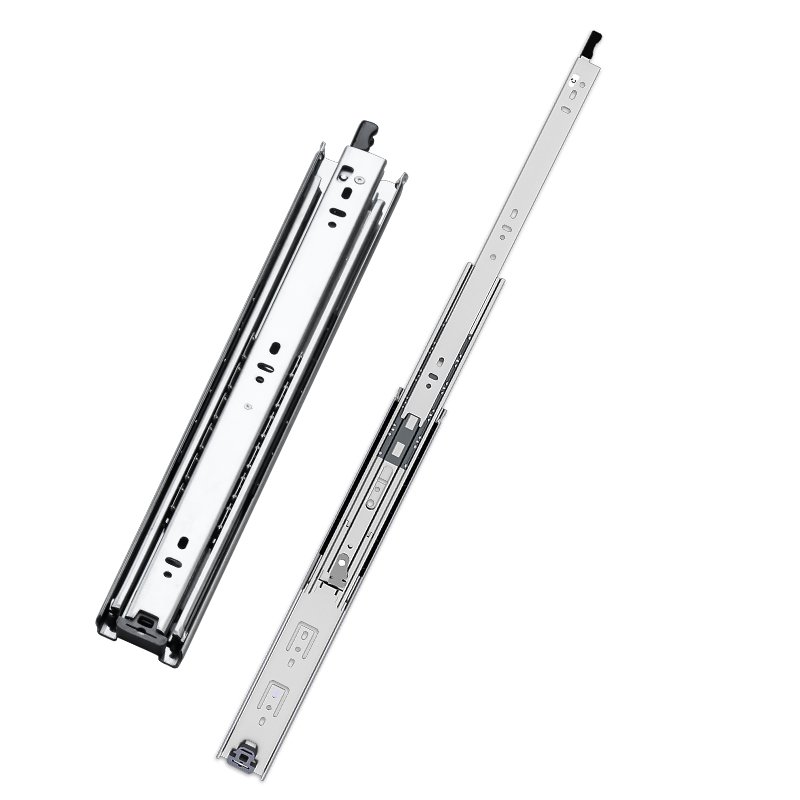heavy duty drawer slides
Looking for a different size or weight capacity? Click below to discover our full range of heavy-duty drawer slides that perfectly fit your needs!

Heavy Duty Locking Drawer Slides - D5115
150 lbs
Material: Cold-rolled steel/Q235
Slide width: 51mm
Installation thickness: 13±0.5mm
Slide length: 12″ to 40″
Load bearing: 18“150 lbs (68kg)
Level of travel: Full Extension
Mounting type: Side Mount
Customizable heavy duty locking drawer slides size, function, hole position, color, etc.
Application Segment
vehicle modification, industrial storage, medical equipment storage, electronic products, etc.



Specific Advantages of
Heavy Duty Locking Drawer Slides
1. Enhanced Safety and Stability: Heavy duty locking drawer slides reduce the risk of accidents and equipment damage by securely fixing devices or items, particularly in high-risk or frequently moved environments.
2. Operational Convenience and Flexibility: Designed for easy locking and releasing, heavy duty locking drawer slides save time and labor costs, enhancing operational convenience and efficiency.
3. Maintenance Cost and Efficiency: Stable equipment fixation reduces repair and replacement costs caused by equipment movement or instability, prolonging equipment lifespan and reliability.
In summary, heavy duty locking drawer slides are critical in enhancing safety and stability improving operational efficiency, and ensuring long-term equipment reliability in applications requiring precise position control and secure fixation.
Our Services
MOQ Offered
We provide flexible minimum order quantities, allowing you to start small and scale up as needed.
Large Inventory
Ensuring Ample Stock for Immediate Shipment, Eliminating Wait Times for Production.
Complete Specifications
We refine various specifications of drawer slides according to different usage scenarios.
AOLISHENG produces drawer slides with standard specifications and provides customized solutions to meet your project needs.
Why Choose AOLISHENG
Rich Experience
- 15 years of industry experience.
- Extensive customization experience.
Production Automation
- Over 90% automation in production.
- Production efficiency increased by more than 10 times.
Quality Assurance
- High-quality products certified with SGS and EN standards.
- Stringent inspection department.
Mass Production
- Factory area of over 40,000 square meters.
- Daily production capacity of over 100,000 sets.
Leading Quality
- Hundreds of professional production machines.
- 5 times product accuracy.
We Look Forward To Your Contact
AOLISHENG is your trusted global partner for high-quality drawer slide production, with strategic factories worldwide and professional local service teams. Partnering with AOLISHENG ensures efficient project delivery, robust supply chains, expert technical support, and a thriving customer base.
FAQ
What is a drawer lock called?
Drawer locks are often referred to as “drawer locks” or “drawer locks”. Drawer locks also have different professional names depending on the type and design. Here are some common drawer lock types and their names:
1. Cylinder Lock: This lock usually contains a round lock cylinder that is operated by inserting a key. It is suitable for various drawers and cabinet doors and can provide high security.
2. Sliding Lock: A lock for drawers that locks by a sliding mechanism. Usually includes a sliding metal rod or tongue to fix the drawer.
3. Knob Lock: The knob lock on the drawer is a mechanism that locks and unlocks by rotation. This lock is usually simple in design and easy to operate.
4. Spring Lock: This lock uses a spring mechanism to keep the drawer locked, and the spring component needs to be pressed or twisted to unlock.
5. Keyed Lock: The drawer lock is equipped with a key for unlocking and locking. It can be in the form of a mortise lock, a knob lock, etc.
6. Combination Lock: This is a drawer lock that is unlocked by entering a specific combination of numbers, without the need for a key.
7. Electronic Lock: A drawer lock that is locked and unlocked by an electronic device, usually requiring a password or an electronic key.
Each drawer lock has its specific design and purpose. Choosing the right lock according to actual needs can effectively improve security and convenience.
How do lock sliders work?
There are several main aspects to how lock sliders work:
1. Locking mechanism:
Design: Locking drawer slides usually have a built-in locking mechanism, such as a locking pin, spring, or gear system. This mechanism can fix the locking drawer slides in a specific position and prevent it from moving.
Operation: The locking mechanism is activated using a locking device (such as a key, button, or slider) to keep the locking drawer slides in a fixed state. When unlocked, the locking mechanism is released, allowing the locking drawer slides to move freely.
2. Sliders and tracks:
Sliding: As the slider slides in the track, the locking mechanism can be inserted into the groove or hole in the track by a fixing device (such as a locking pin) to fix the position of the slider.
Free movement: When the locking mechanism is released, the slider can slide freely on the track or adjust its position.
3. Operation:
Locking operation: Inserting or turning a key, pressing a button, or moving the slider itself triggers the locking mechanism, which fixes the slider in its current position.
Unlocking operation: Accordingly, turning a key, pressing an unlock button, or moving another part of the slider releases the lock, allowing the slider to move again.
4. Application scenarios:
Safety: In equipment that requires additional security, such as drawers, doors, chassis, etc., locking drawer slides are used to prevent unauthorized operation or adjustment.
Control: Used to control the movement range or position of the equipment to ensure that the equipment or components are fixed in a specific state.
Through this locking and unlocking mechanism, the locking drawer slides can provide stability and security, ensuring that the equipment can be fixed in a specific position when required while providing flexible adjustment functions when allowed.
How to disconnect locking drawer slides?
To disconnect locking drawer slides, you typically follow these steps. The specific steps may vary depending on the design and manufacturer of the locking drawer slide, but in general, you can refer to these general methods:
1. Prepare tools and materials
Tools: Screwdriver (usually Phillips or flat-blade), pliers, and other tools that may be needed (such as pry bars, lubricants, etc.).
Safety measures: Wear gloves and ensure that the working environment is clean and safe.
2. Check the locking mechanism
Understand the locking type: Identify the locking mechanism of the slide to determine whether it is a spring lock, sliding lock, or other type of locking device.
3. Open the drawer
Fully open: Open the drawer fully, which will provide better operating space and viewing angle.
4. Unlock
Find the lock release:
Some locking drawer slides have a release button, pull ring, or slider that can be pressed or pulled to unlock.
Other types of locking drawer slides may require the use of a key or the operation of a specific locking mechanism.
Operate the release: Operate the release to unlock the lock according to the design requirements of the locking drawer slide.
5. Remove the slide rail
Check the fixing screws: Confirm whether the slide rail is fixed to the cabinet or drawer with screws. Use a screwdriver to remove the fixing screws.
Disconnect the slide rail:
Connect the slide rail to the cabinet: Usually, one part of the slide rail is fixed to the cabinet and the other part is fixed to the drawer. After unlocking, you can gently pull out a part of the slide rail to separate the slide rail and the drawer.
Connect the slide rail to the drawer: In some slide rail designs, it is necessary to unlock the fixings on the slide rail and the drawer at the same time to completely disconnect the slide rail from the drawer.
6. Remove the drawer
Remove from the slide rail: After the slide rail is completely unlocked and removed, gently move the drawer away from the slide rail. If there is still a stuck place on the slide rail, you can shake it appropriately or pry it gently.
7. Inspection and maintenance
Check the status of the slide rail: After disconnecting the slide rail, check the status of the slide rail and the drawer to confirm that there is no damage. Clean and maintain if necessary.
Notes:
Follow the manufacturer’s instructions: Different types of slide rails may have different locking and disconnection methods. It is recommended to consult the installation or removal instructions provided by the slide rail manufacturer.
Be careful: Avoid using excessive force during operation to avoid damaging the slide or drawer.
With the above steps, you can safely disconnect the locked drawer slide. If the slide design is more complicated, you may need to refer to the specific product manual or seek professional help.
